Dorothy Gray (post 1945)
Continued from: Dorothy Gray (1930-1945)
Dorothy Gray faced a number of immediate problems after the war. Overseas parts of the company cut off during the war had to be reconnected; bomb damage to the British and French factories repaired; and, in the United States, production restrictions caused by continuing shortages of raw materials and limited manufacturing capacity overcome.
In 1947, the American arm of Dorothy Gray also underwent a relocation. Lehn & Fink, Dorothy Gray’s parent company, moved their New York offices from 683 Fifth Avenue to the newly completed Tishman (later Universal Pictures) Building at 445 Park Avenue and the New York Dorothy Gray offices and salon went with them. The new salon celebrating its opening with an exhibition of original paintings featured in upcoming Dorothy Gray advertisements titled ‘The Dorothy Gray Gallery of Fascinating Women’.
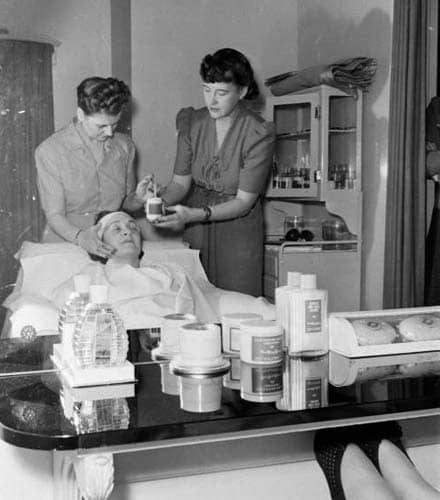
Above: 1956 A facial treatment room in the Dorothy Gray salon at 445 Park Avenue, New York.
The Dorothy Gray packaging was also given a post-war refresh with the company’s day-to-day cosmetics restyled in solid blue containers in 1948. By then, Dorothy Gray had also stopped using the 1940s tagline ‘American Design of Beauty’ switching to ‘Trust Dorothy Gray’ in 1950.
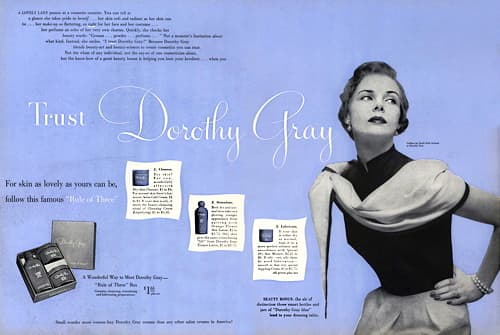
Above: 1950 Trust Dorothy Gray.
Dorothy Gray began to move away from this blue and white packaging in 1953 when Satura Moisturizing Cream arrived but not before it introduced its Wedgwood Series-in-Scent (1953) – Perfume, Dusting Powder and Eau de Cologne, and Cologne Stick all packed in blue, Wedgwood-inspired containers.
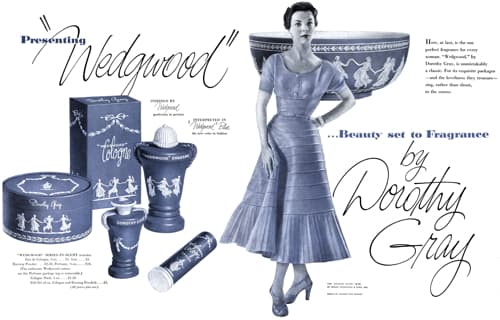
Above: 1953 Dorothy Gray Wedgwood.
Television
The success of Hazel Bishop’ Lasting Lipstick resulted in many of the larger American cosmetic companies moving much of their advertising revenue into television. Television advertising is a mass-marketing medium and was very expensive which required selling on scale to support it. As Revlon came to realise, it also tended to cheapen brands – cosmetics advertised on it often lost status.
See also: Hazel Bishop and Revlon (1945-1960)
Lehn & Fink spread the costs its television advertising across its Lehn & Fink, Tussy, and Dorothy Gray brands. Even so, the additional expenses incurred by television often outstripped the increased revenue it generated.
See also: Lehn & Fink
Two early shows sponsored by Lehn & Fink were ‘The Ray Bolger’ show on ABC-TV and early Sunday evening re-runs of ‘I love Lucy’ on CBS. An oft-mentioned advertisement from this period was for Dorothy Gray Salon Cold Cream which had its effectiveness tested with radioactivity gimmickry.
Also see the associated booklet: Dorothy Gray Salon Cold Cream cleanses 2½ times faster
Products
Until 1955, all Dorothy Gray skin-care and make-up cosmetics were only sold under the Dorothy Gray brand. This began to change after 1955 when the company began to develop ‘flankers’ for two of its most successful products – Satura Moisture Cream and Sheer Velvet Film. Each would be developed into a limited skin-care and make-up line and become a major focus of the firms advertising efforts.
Skin care
In the late 1940s, Dorothy Gray stopped advertising the three problem areas it had stressed before the war – nose, eyes and throat – but continued with its three-step treatment guides. However, the post-war ‘Rule of Three’ now became 1. Cleanse, 2. Stimulate, 3. Lubricate, rather than the ‘cleanse, lubricate and stimulate’ regime used in the 1930s. This change brought Dorothy Gray more in line with accepted practice of cleansing make-up, then using a tonic or astringent to remove the last traces of the cleanser and ‘close the pores’, before finally applying a skin cream or powder base. As before, separate treatments were laid out for normal, dry, and oily skin types.
Cleanse.
Dry skin? For you, wonderfully effective Dry-Skin cleanser. For normal skin there’s luxurious Salon Cold Cream. If your skin is oily, it needs the beauty-cleansing ritual of Cleansing Cream (liquefying).
Stimulate.
Both dry and normal skins take on a glowing, younger appearance from patting with Orange Flower Skin Lotion. Oily skin gets the same stimulating “lift” from Texture Lotion.
Lubricate.
If the skin is either dry or normal, coax it to a more perfect softness with Special Dry-Skin Mixture. If oily—yes, oily skins do need lubrication—smooth in that very special Suppling Cream.(Dorothy Gray advertisement, 1950)
By 1950, Dorothy Gray had also added a three-step regime for combination skin.
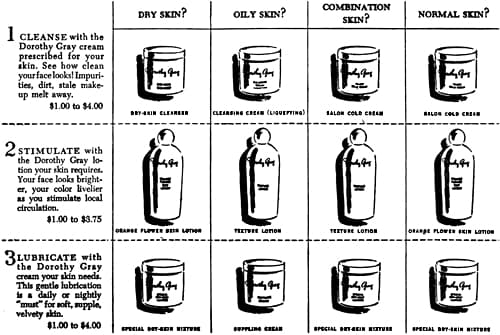
Above: 1950 Dorothy Gray three-step treatments:
Dry Skin: 1. Dry-Skin Cleanser; 2. Orange Flower Skin Lotion;
3. Special Dry-Skin Mixture.
Oily Skin: 1. Cleansing Cream (Liquifying); 2. Texture Lotion;
3. Suppling Cream.
Combination Skin: 1. Salon Cold Cream; 2. Texture Lotion;
3. Special Dry-Skin Mixture.
Normal Skin: 1. Salon Cold Cream; 2. Orange Flower Skin Lotion;
3. Special Dry-Skin Mixture.
There were variations on this routine but all held true to the three-step idea. The one below from Britain includes a routine for sensitive skin using Dorothy Gray Sensitive Skin Cream which debuted in the United States in 1931.

Above: 1958 Dorothy Gray treatments for various skin types (UK).
Until 1950, all of the Dorothy Gray three-step skin-care routines used cosmetics developed before the Second World War. Adjustments to them would be made in the 1950s as new products came on the market.
Additives
Dorothy Gray had added vitamins A and D to some of its skin care cosmetics in 1937 but it was not until 1944 that it introduced Cellogen Cream, its first skin-care cosmetic containing hormones.

Above: 1950 Dorothy Gray Sweet Suggestion Toilet Water, Cellogen Cream, and Magnum Lipstick (UK).
After the war Dorothy Gray added a range of hormonal skin-care cosmetics including: Dorothy Gray Estrogenic Hormone Lotion (1948); Hormone Hand Cream (1949), sometimes called Cellogen Hand Cream; Remoldine (1952), a reformulated hormone version of an older bust cream; Cellogen Hormone Lotion (1953); Satura Moisture Cream (1953); and Satura Lotion (1957). Some make-up items countering hormones were also added but In will discuss those later.
The hormone levels in these preparations varied. For example, Estrogenic Hormone Lotion contained 5,000 International Units (I.U.s) per ounce of hormone but Hormone Hand Cream and Satura Moisture Cream were formulated with 10,000 I.U.s of hormone per ounce. Satura was also formulated with vitamin A, and both Satura and Remoldine also contained Elfanol, a trade-named lanolin derivative.
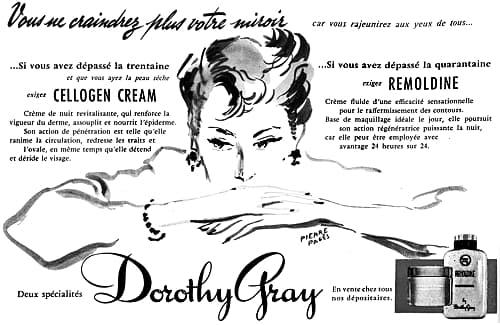
Above: 1954 Dorothy Gray Cellogen and Remoldine (France).
Estrogenic Hormone Lotion: “Magic new formula containing natural estrogenic hormones. Helps keep the face, neck, throat and hands looking younger. Wonderful as a powder base.”
Hormone Hand Cream: “[A] luxurious vanishing cream that smooths in new softness. … Leaves hands and rough spots wonderfully smooth . . . is never sticky or greasy.”
Remoldine: “A contour facial, a ‘tightener’ to help form sagging, lined or puffy skin. Contains gentle astringents to firm, emollients to soothe, and hormones to ward off signs of age. (Also without hormones for younger women)”
Satura Moisture Cream: “A superb cream to give the skin all-important moisture. Actually draws moisture from the air and holds it against the skin’s surface. Contains hormones to ‘cushion’ skin, Vitamin A to combat flakiness.
Satura
Satura Moisture Cream was a pink, vanishing type cream that could be used as a moisturiser, night cream, or powder base. As mentioned previously, other cosmetics were introduced to create a Satura line: Satura Lotion (1956); Satura Cleansing Cream and Satura Skin Freshener (1960); as well as versions of Satura Cream and Satura Lotion with vitamin A but without hormones. Make-up items added to Satura will be looked at later.
Satura Cleansing Cream: “A gentle effective cream for dry or normal skin. One application removes make-up and grime quickly, thoroughly.”
Satura Skin Freshener: “Stimulating lotion for dry and normal skin. Mildly astringent. Leaves complexion refreshed and glowing.”
Satura Cream with hormones and vitamin A: “The perfect make-up base. A greaseless vanishing cream that attracts and holds moisture.”
Satura Cream with vitamin A: “Use this greaseless vanishing cream before applying make-up. Helps keep your skin young and fresh.”
Satura Lotion with hormones and vitamin A: “A lotion moisturizer that keeps your skin smoother, younger looking when applied daily.”
Satura Cream with vitamin A: “A moisture lotion for dry skin. Prevents flaking and cold weather drying and chapping.”
Hormones and vitamins were not the only additives used by Dorothy Gray in the 1950s. In 1955, Allantoin was added to Dorothy Gray Dry Skin Lotion, and Dorothy Gray Sili-Creme Lotion, a silicone-based protectant. Royal jelly, a popular additive in the 1950s was included in Abunda, a ‘kitchen skin’ cosmetic introduced by Dorothy Gray in 1957.
Abunda: “[O]ne of the greatest achievements of cosmetic science today. Contains every ingredient of proven value as a skin beautifier. Actually helps to restore a firmer, younger look to skin. … Contains 50,000 Vitamin A U.S.P. units per ounce, 10,000 units of natural estrogenic hormones per ounce the highest concentration for cosmetic efficacy, and vita-cos, a highly beneficial, modern ‘polyunsaturate’ complex, especially for dry skin. Also Royal Jelly, precious oils and moisturizers.”
See also: Royal Jelly
Others
Other skin-care cosmetics added through to 1960 included: Dorothy Gray Liquid Cleansing Cream for dry and normal skin types (1950); Dorothy Gray Dual-Purpose Emollient (1950), a night cream and/or a powder base; Dorothy Gray Quick Cleansing Cream (1953), a lotion for oily skins containing Bithionol to help prevent blemishes; and Dorothy Gray Outline (1957), a contour lotion. Outline, came in two formulations, selected according to skin type. It was applied with a cotton pad massaged in with long upward strokes, after a thorough facial cleansing.
Liquid Cleansing Cream: “Ideal for dry or normal skin. Convenient for frequent use at home, office or for travel. It leaves the skin refreshed and fragrant, ready for applying make-up.”
Dual-Purpose Emollient: “[A] greaseless, overnight lubricating lotion that doubles as the perfect daytime powder base for dry skin.”
Quick Cleansing Cream: “[A] liquid cleanser to remove stale makeup.”
Outline: [A] new type beauty treatment. It contains an ingredient that helps firm up facial contours by reducing heavy or sagging skin. There are two formulas. Outline No. 1 and No. 2. One is for dry and normal skin. Two is for blemished or excessively oily skin. All women from teens to matrons can use the formulas to alleviate either dryness and flaking or greasiness and diminishing tautness.”
Make-up
Dorothy Gray added a number of new make-up items after 1945 but most did not survive the highly competitive years of the 1950s. As well as television, the company had to contend with the increasing influence of the fashion cycle, a trend intensified by the rise of Revlon; the growth of the youth market; and the introduction of new forms of make-up.
Foundations and powders
In 1945, Dorothy Gray was producing a range of loose face powders, compacts and foundations. Some of these had been available before the war – e.g.; Portrait Face Powder, Nosegay Face Powder, Elation Face Powder, Elation Make-up Film, and Blustery Weather Lotion – while others, like Finisheen Cream, were more recent additions.
In 1945, a number of new Dorothy Gray make-up items became available includIng: Lights Up, a liquid foundation in five shades; Portrait Make-up, a compact foundation in Suntone, Rachel, and Special Blend tones; and Elation Make-up Balm, a colourless foundation and skin protectant formulated as a liquid emulsion. Some pre-war products such as Dorothy Gray Pearly Powder Base, and Dorothy Gray Finishing Lotion appear to have been depreciated or discontinued.
In 1946, Dorothy Gray added Angel Cake, a creamy foundation produced as a compact. Like Dorothy Gray Portrait Make-up it does not appear to have survive into the 1950s.
Angel Cake: “[A] foundation cream in cake form. It has a creamy base . . . . is not only non-drying, but actually helps a Dry Skin by protecting the skin against the drying effects of weather and wind.” Shades: Fair, Special Blend, Rose-Glo, Pink Rachel, and Double Rachel.
Sheer Velvet
In 1952, Dorothy Gray launched the previously mentioned Sheer Velvet Film, a tinted, liquid foundation. Sheer Velvet Cake Foundation was also added then with a hormone version of Sheer Velvet Film arriving in 1953. Other cosmetics added in the 1950s to produce the Sheer Velvet line included: Sheer Velvet Compact (1955) in plastic and metal containers; Sheer Velvet Face Powder (1955); Sheer Velvet Lipstick (1956); Sheer Velvet Cleanser (1956); and Sheer Velvet Hair Spray (1956).
Sheer Velvet Film: “[A] creamy liquid foundation that smooths on glowing color and a flawless-looking complexion finish. As it tints, it helps protect, it smooths, and conceals tiny imperfections.” Shades: Special Blend, Rachel, Glo-Rachel, Fair, and Suntone.
Sheer Velvet Compact: “[B]lends together your powder and a protective foundation that covers without caking and looks dewy fresh without shining. Convenient for quick make-ups.” Shades: Special Blend, Rachel, Glo-RacheL, South American, and Suntone.
Sheer Velvet Face Powder: “[A] gossamer powder formulated to ‘Veil’ your face with a delicate radiance, and conceal shadows and tiny flaws.” Shades: Special Blend, Glo-Rachel, Rachel, South American, Tawny Rachel, and Suntone.
Satura
As mentioned earlier, the Satura line also had make-up items added to its range. In 1957, Dorothy Gray added Satura Sheen, a tinted, liquid, moisturising foundation followed by Satura Lipstick in 1958.
Satura Sheen: “[A] foundation liquid that blesses dry or drying skin with dewy freshness. … [A] marvelous moisturizer that helps guard your skin against weathering by blustery winds, chapping cold. In addition it gives you skin the smoothest, most natural-looking base for powder.” Shades: Natural, Peach-Glo, Cream Rachel, Dusty Rose, Cocoa, and Tropic.
Lipsticks and rouge
Dorothy Gray had returned to metal lipstick cases in 1944. The lipsticks came in two forms – creamy and long lasting, in Brass Band, All Clear Red, Red Letter, Daredevil Red, Nut Brown Red, and Siren shades. New lipstick formulations included: Super-Stay (1951), Sheer Velvet (1956), and Satura (1958) lipsticks, with Liquessence Lipsticks added in 1964.
Dorothy Gray Super-Stay Lipstick was an indelible. It followed the success of Hazel Bishop’s Lasting Lipstick (1950), another indelible that started the 1950s Lipstick Wars in the United States. Following the release of Super-Stay, older Dorothy Gray lipstick formulations were then referred to as regular.
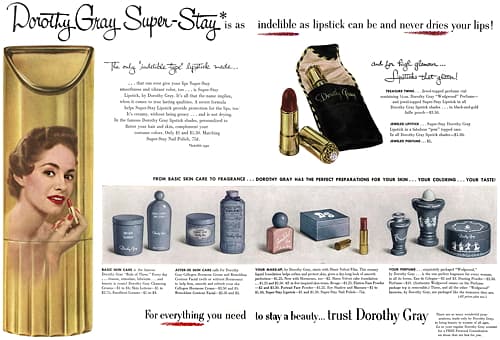
Above: 1953 Dorothy Gray Super-Stay Lipsticks.
Super-Stay Lipstick: “Lets you kiss and never tell! Lets you eat, dink, smoke . . . with never a smudge or smear.” Shades: Red Trey, Really Pink, South American, Ripe Cherries, Nut Brown Red, Right Red, Siren, Nosegay, and Portrait Pink.
See also: Lipstick Wars
Sheer Velvet Lipstick was introduced when interest in indelibles began to wane after 1954 and new creamy formulations began to appear. Its addition meant that the company then had three lipsticks in its inventory – Regular, Super-Stay, and Sheer Velvet. Two years later, Dorothy Gray added Satura Lipstick in four shades. It was differentiated from Sheer Velvet with moisturisers, separate shades and its own case.
Sheer Velvet Lipstick: “[G]ives ripe-red richness that stays that way all day, all night. Slips over lips like softest velvet, contains softening ingredients which guard lips against dry, puckery feel.” Shades: Right Red, Siren, Portrait Pink, Figurine Look, Queen’s Taste, and Tangerine.
Satura Lipstick: “[W]ith an amazing moisturizing ingredient to keep lips softer, smoother, more tempting than ever! The exciting color goes on smoothly, never drys your lips or lets them chap.” Shades: Wild Peach, Apple-on-a-Stick, Royalty Red, and Flamboyant.
Along with new formulations, Dorothy Gray also made regular announcements of new lipstick shades. In the United States those that I know of were: Right Red, Portrait Pink, and Blackberry (1945); Really Pink, and Bright Touch (1946); Trans-World, and Sea Siren (1947); Queen’s Taste, Vintner Red, Royalty, Falcon, and Bermuda Coral (1948); Divine Spark, Deep Spark, and Flamboyant (1949); Red Trey, and Cherry Bounce (1950); Fuchsia, Bright Lilac, Sea Coral, and Drum Red (1951); Spring Crocus (1952); Figurine Look (1954); Sheer Red, and Elation Red (1955); Edwardian Rose (1956); Royalty Red (1957); Apple-on-a-Stick, and Wild Peach (1958); Real Gone Red, Real Cool White, and Real Hot Orange (1959); Plum Sizzle, and Ginger Snap (1960); Jelly Bean Pink, Orange Peel, Pink Plunge, and Coral Splash (1961); Jewel of India, Coral Flame, and Firelight Red (1962); Coral Sail, and Spinnaker Pink (1963); and Light Up Yellow, Surprisingly Red, V. I. Pink, and V. I. Peach (1964). Dorothy Gray harmonised these shades with Dorothy Gray Cream and Compact Rouges. Many were also matched with Dorothy Gray Nail Polishes.
Eye make-up
Dorothy Gray eye make-up languished relatively unattended through most of the 1950s until the introduction of Helena Rubinstein’ Mascara-matic (1957) appears to have triggered a major update.
In 1958, Dorothy Gray introduced Beauti-Lash, an automatic mascara very similar to the Mascara-matic. Like the Mascara-matic, it used a rod applicator only switching to a brush by 1962. In 1959, this was followed with other new forms of eye make-up including: Eye Duo containing a retractible eyebrow pencil at one end and eyeliner at the other; and Eye Shadow Stick, an eyeshadow that functioned like a lipstick.
Beauti-Lash Mascara: “No more dipping! No more brushes! This little cylinder is self-wiping; you just sweep it under your upper lashes, over your lower lashes. Tiny grooves curl and color each lash separately. Then slide the cylinder back in its holder; each time, a new supply of mascara.” Shades: Black, Brown, Blue, and Green.
Eye-Duo Pencil: “Make your eyes the beautiful focal point! Handy to tuck into your handbag and refillable too.” Shades: Brown, Black, Charcoal, and Auburn.
Eye Shadow Stick: “Adds compelling depth.” Shades: Violet, Turquoise, Royal, Green, Gray, Blue, and Brown.
See also: Automatic Mascara
Youth market
In 1952, Dorothy Gray added an antimicrobial to its existing Dorothy Gray Hygenic Paste, and Hygenic Lotion. The antimicrobial was hexachlorophene – a compound that got a lot of cosmetic companies into trouble in the 1970s.
See also: Hexachlorophene
Hexachlorophene was then added to some of the products in the new Dorothy Gray Scrub Kit (1956). Designed for troubled skins generally associated with a younger demographic, the three items in the Scrub Kit – Dorothy Gray Medicated Scrub Soap, Medicated Refining Lotion, and Medicated Blemish Cream – were combined into another three-step routine. However, rather than ‘cleanse, lubricate and stimulate’, the message here was ‘clean, clear and medicate’.
1. Clean: Medicated Scrub soap goes deep to root out clogging grime, hardened oil and make-up. Special oatmeal ingredient stimulates surface circulation, helps rid skin of deep-seated impurities.
2. Clear: Medicated Refining Lotion keeps troublesome bacteria in check.
3. Medicate: Medicated Blemish Cream promotes healing of blemishes all night long.(Dorothy Gray advertisement, 1958)
Two other Dorothy Gray products aimed a teenagers that contained hexachlorophene were Dorothy Gray Foundation 445 (1956) and Velveteen Night Cream (1957). Like the earlier Cream 683, Foundation 445 seems to have been named for the address of the Dorothy Gray Salon. It came in two shades, one for ivory or pink skins, the other for rosy or peach tones. As well as teenagers it was recommended for older women whose skin was dry but inclined to be oily around the nose.
Velveteen Night Cream was closely aligned with the items in the Dorothy Gray Scrub Kit and was packaged in a similarly coloured container. The Velveteen name helped create a mental bridge between Sheer VELVET and TEENagers and would be used on other products in the 1960s.
Foundation 445: “[A] medicated, tinted make-up base that helps dry and conceal blemishes and controls complexion shine.’ Shades: Fair, and Special Blend.
Velveteen Night Cream: “[W]ith hexachlorophene to give you nightly conditioning for a smooth, soft complexion.”
In 1958, hexachlorophene was also added to Dorothy Gray Liquid Cleansing Cream which was then rebranded as Two (2) Minute Magic.
Two Minute Magic: “A superb, creamy skin cleanser that is non-drying, leaves skin soft and smooth. Two Minute Magic is rich in texture, never sticky or greasy and easy to apply.”
Hair-care
In 1956, Lehn & Fink bought The Olgivie Sisters, a hair-care range and combined it with Dorothy Gray. This helped filled a gap in the company’s product range and allowed it to get into the home permanent and home colouring market about which I have little interest and therefore little to say.
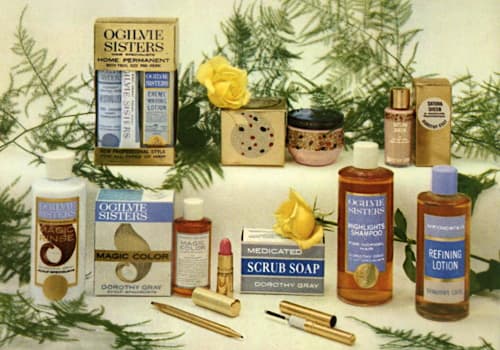
Above: 1959 Dorothy Gray Ogilvie Sisters products along with assorted Dorothy Gray skin-care and make-up items.
As the years progressed Dorothy Gray became more prominent on the packaging but the integration remained an uneasy fit.

Above: 1963 Dorothy Gray – Ogilvie Sisters.
See also: Basic Treatment Sales Help (c.1954) and Sales Training Course (c.1955)
1960s
Dorothy Gray introduced a number of new skin-care and make-up cosmetics between 1960 and its sale in 1966.
Skin-care
The main skin-care addition during this time was Secret of the Sea (1961), a pale, aqua-blue treatment cream that combined moisturizers, emollients and other active agents to combat dry skin. Introduced initially as a cream, a lotion formulation quickly followed. By 1966, Dorothy Gray had added bath oils and make-up and turned Secret of the Sea into yet another a line.
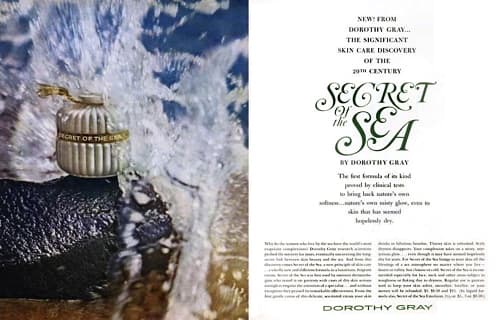
Above: 1962 Dorothy Gray Secret of the Sea.
Secret of the Sea: “The first formula of its kind to help bring back nature’s own softness, nature’ own smoothness, even to skin that has seemed hopelessly dry. … [A] wholly new and different cream . . . fluffy, delicate, light-and-Iovely-to-the-touch. Even the color is new. … Regular use of this astonishing cream is guaranteed to keep your skin softer, smoother, lovelier.
Make-up
Dorothy Gray added two new lipsticks in the early 1960s, Fashion Slim Lipsticks (1961), a lipstick and liner in one, and Liquessance (1964), an oval-shaped lipstick that supposedly gave the lipstick a ‘unique application concept’. Fashion Slim debuted in twelve shades along with the new Dorothy Gray Fashion Finish Nail Enamels which came in twelve matching colours plus four iridescent shades. Liquessence was introduced in twenty shades.
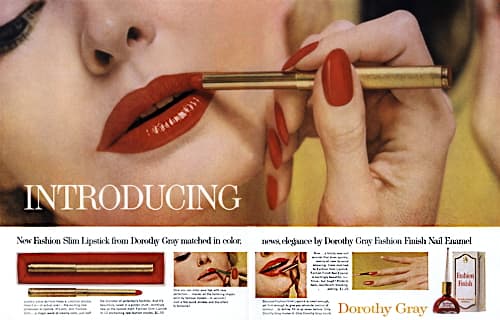
Above: 1961 Dorothy Gray Fashion Slim Lipstick in a Florentine-finish contourband case and Fashion Finish Nail Enamel.
Fashion Slim Lipstick: “[A] long, slender wand of color that outlines, defines even better than a lipstick brush.” Shades: Blush Pink, Portrait Pink, Jewel of India, Apple on a Stick, Really Pink, Figurine Look,
Tangerine, Siren, Flamboyant, Edwardian Rose, Wild Peach, and Right Red.
Liquessence: “[C]reates an invisible vapor barrier which prevents natural moisture from evaporating. Lips can look young can stay young. And, It comes In a new completely oval case that Is refillable and features a unique application concept.
Fashion Slim was Dorothy Gray’s second slim-line lipstick. When this form of lipstick first became popular in the late 1940s, Dorothy Gray created Divine Spark Lipstick Couplet (1949), a set of two red lipsticks – Deep Spark, a deeper shade to shape the curve of the lip and give it depth and Divine Spark, a lighter shade of red to fill in and highlight the lips. The Deep Spark lipstick looked like an ordinary lipstick in the box but had a cap which, when attached to the lipstick base, turned to lipstick into a pencil which was supposed to make it easier to draw in the lip outline.
Following the Fashion theme, Dorothy Gray would follow to the Fashion Slim Lipstick and Fashion Finish Nail Enamel with Fashion Touch Foundation in 1963.
Fashion Touch Foundation: “Light in texture, lastingly lovely, helps conceal imperfections with a gossamer film that lets your natural beauty show through!” Shades: Natural, Cream, Peach, Rose, Beige, and Cocoa.
New lipstick shades added in this period included: Jelly Bean Pink, Orange Peel, Pink Plunge, and Coral Splash (1961); Coral Flame, and Firelight Red (1962); Coral Sail, and Spinnaker Pink (1963); Light Up Yellow, Surprisingly Red, V. I. Pink, and V. I. Peach (1964); Platinum Red, Sable, Plush Pink, and Rogue’s Gold (1965); Hawaii (1966); Navy Pink, Navy Red, Navy Coral, Glimmer Red, Glimmer Pink, Glimmer Coral, and Glimmer Gloss (1967).
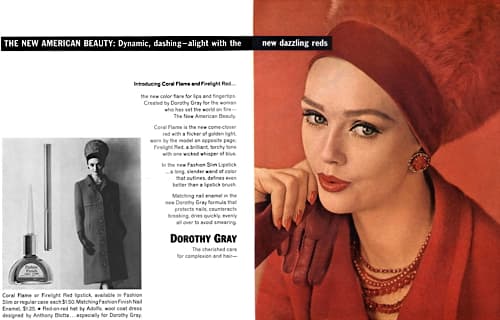
Above: 1962 Dorothy Gray Coral Flame and Firelight Red.
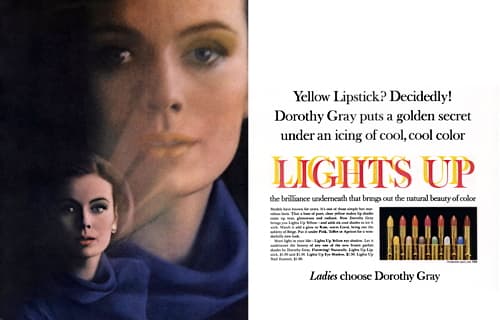
Above: 1964 Dorothy Gray Lights Up.
In eye make-up, Dorothy Gray would add Double-Take. Like the earlier Eye-Duo, it combined two make-up items in one – an eyeshadow in plain or iridescent Blue, Green, Violet, or Turquoise shades at one end, an automatic mascara with a brush at the other. Both Eye-Duo and Double-Take were refillable.
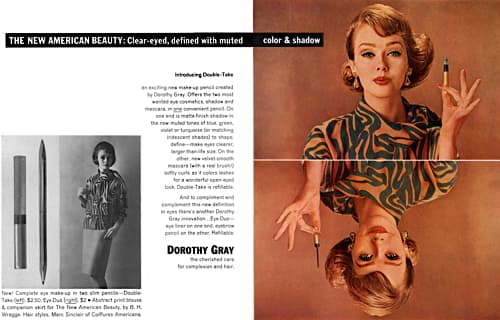
Above: 1962 Dorothy Gray Double-Take.
Youth Market
The success of Noxema’s Cover Girl make-up range released in 1961 may have induced Dorothy Gray to add its own make-up cosmetics specifically for the teenage market later in that year. Velveteen Compact and Velveteen Fluid Make-up in five matching shades including Cream Beige, Pale Peach and Tawny were added to the older Velveteen Night Cream. Like Cover Girl, both cosmetics contained hexachlorophene.
Velveteen Fluid Make-Up: “For a creamy, smooth foundation.”
Velveteen Compact: “Smooths over complexion flaws beautifully, gives you an all-day beauty treatment.”
If the skin was particularly troubled then items from the Scrub Kit – now called Scrub Mates – were advised for ‘treating and clearing’.
See also: Cover Girl and How to make the most of your Natural Beauty (c.1963)
Later developments
In 1966, Lehn & Fink was bought by Sterling Drug, a U.S. pharmaceutical company and this is where my interest in Drothy Gray ends. Sterling Drug was acquired by Eastman Kodak in 1988, the various components of Lehn & Fink were separated and Dorothy Gray along with Tussy and some other components were sold first to Reckitt & Colman in 1994 and then to Playtex Products in 1998. After some unsuccessful reorganisations, Playtex sold a number of its brands, including Dorothy Gray and Tussy to Cenuco in 2005. Unfortunately, Cenuco had financial problems and, after renaming itself Ascendia Brands in 2006, sold Dorothy Gray and Tussy to KCM Brands for $1 million in 2008.
This series of buyouts progressively weakened and then nearly caused the extinction of the brand. It no longer exists in the United States, Europe or Australasia but can still be found in Argentina and Uruguay. The last time I looked, both countries had functioning websites with extensive Dorothy Gray product lines for sale.
Timeline
| 1945 | New Products: |
| 1946 | New Products: Cellogen Lotion. |
| 1947 | American distribution of Suzy Perfumes acquired. New York salon moved to 445 Park Avenue. New Products: Angel Cake. |
| 1948 | Packaging updated in solid blue containers. New Products: Estrogenic Hormone Lotion. |
| 1950 | New Products: Lipstick Couplet; Liquid Cleansing Cream; and Dual-Purpose Emollient. |
| 1952 | New Products: Remoldine; Sheer Velvet Film; and Sheer Velvet Compact. |
| 1953 | New Products: Satura Moisturizing Cream; Cellogen Hormone Lotion; Quick Cleansing Cream; and Cream Stick. |
| 1954 | New Products: Remoldine Body Rub. |
| 1955 | New Products: Sili-Creme Lotion. |
| 1956 | Lehn & Fink buys Ogilvie Sisters and integrates it with Dorothy Gray. New Products: Foundation 445; Satura Lotion; Sheer Velvet Cleanser; and Sheer Velvet Lipstick. |
| 1957 | New Products: Satura Sheen; Abunda; and Velveteen Night Cream. |
| 1958 | New Products: Satura Lipstick; and Beauti-Lash. |
| 1960 | Showroom opened at 8 Grosvenor Road, London. New Products: Sun Tan Lotion. |
| 1961 | New Products: Secret of the Sea; Velveteen Compact; Velveteen Fluid Make-up; and Fashion Slim Lipsticks. |
| 1963 | Dorothy Gray established in Australia. New Products: Fashion Touch Foundation. |
| 1964 | New Products: Liquessence Lipsticks. |
| 1966 | Lehn & Fink sold to Sterling Drug, Inc. |
| 1968 | New Products: Satura Algene. |
| 1988 | Sterling Drug, Inc. acquired by the Eastman Kodak Company. |
| 1994 | Lehn & Fink division of Sterling Drug bought by Reckitt & Colman, Pty. Ltd. from Eastman Kodak. |
| 1998 | Personal Products Division of Reckitt & Colman sold to Playtex Products, Inc. |
| 2005 | Dorothy Gray brand acquired by Cenuco, Inc. |
| 2006 | Cenuco, Inc. becomes Ascendia Brands. |
| 2008 | Dorothy Gray sold to KCM Brands. |
First Posted: 14th October 2010
Last Update: 8th August 2021
Sources
Dorothy Gray. (1954). Trust Dorothy Gray [Booklet]. Great Britain: Author.
Dorothy Gray. (1959). Your personal blueprint for beauty designed by Dorothy Gray [Booklet]. Great Britain: Author.
Dorothy Gray. (c.1963). How to make the most of your natural beauty with Dorothy Gray cosmetics [Booklet]. Sydney: Author.
Lehn & Fink. Annual Reports 1929-1964.
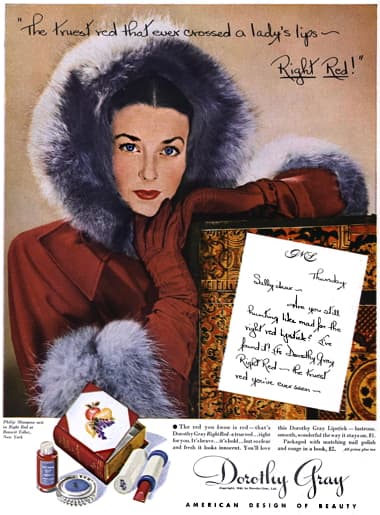
1945 Dorothy Gray Right Red.
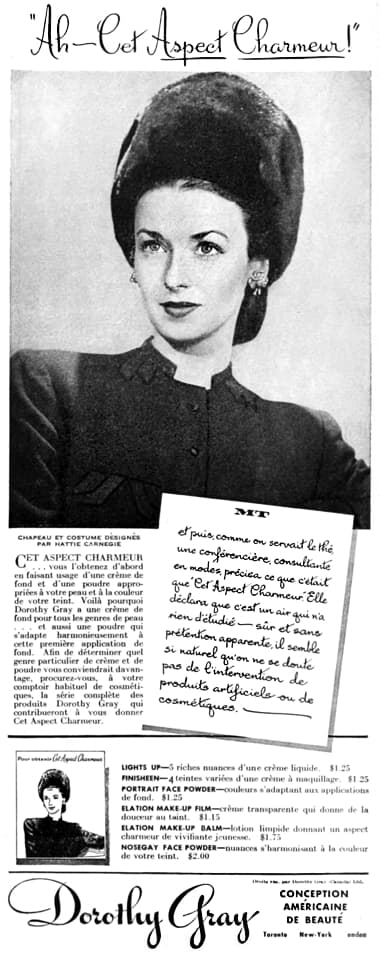
1945 Dorothy Gray (Canada).

1946 Dorothy Gray Angel Cake.

Dorothy Gray Angel Cake.
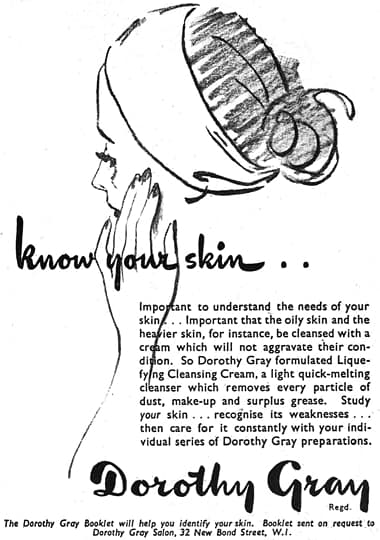
1947 Dorothy Gray Liquefying Cleansing Cream (UK).
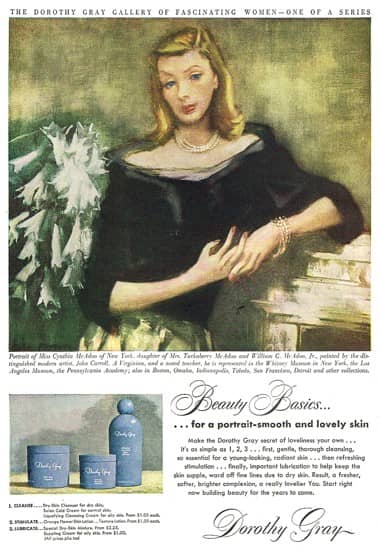
1948 Dorothy Gray Beauty Basics in new packaging.
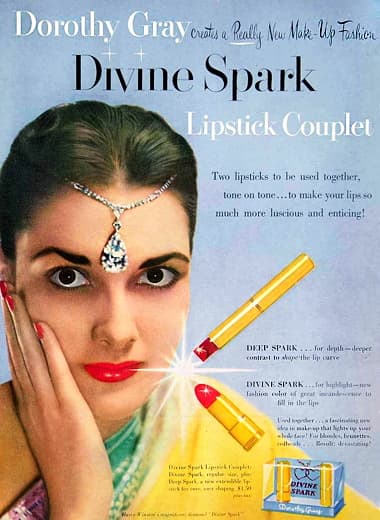
1949 Dorothy Gray Divine Spark.
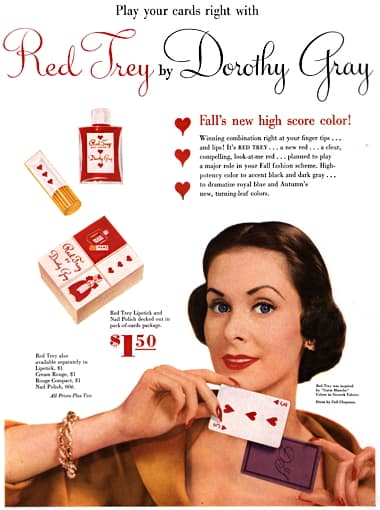
1950 Dorothy Gray Red Trey.
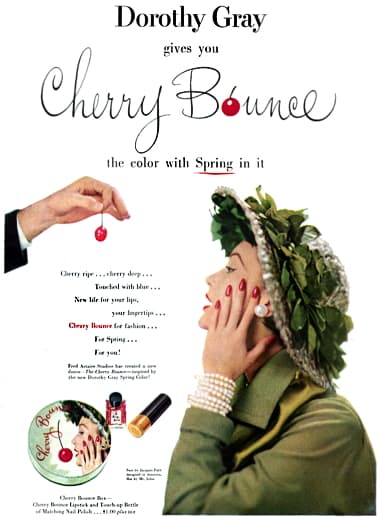
1950 Dorothy Gray Cherry Bounce.
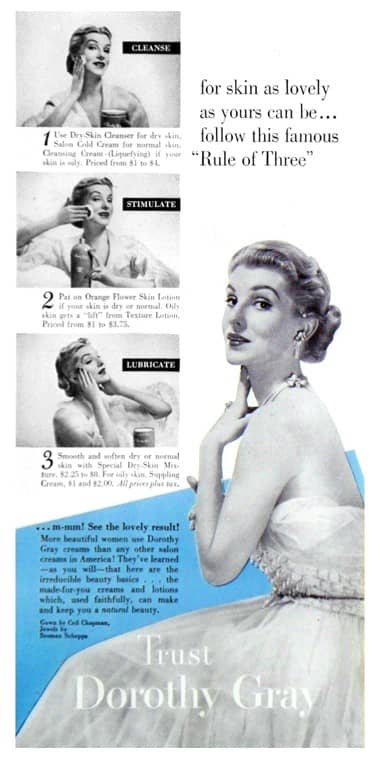
1951 Dorothy Gray. The Rule of Three: Cleanse, Stimulate, Lubricate.
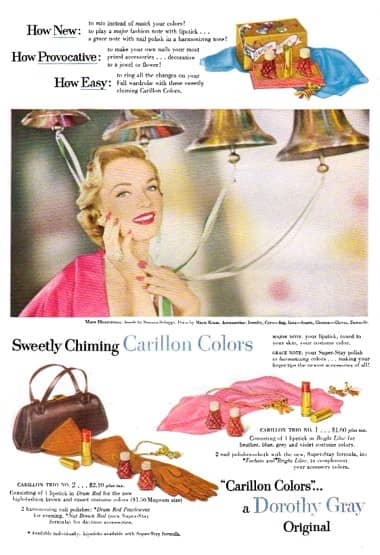
1951 Dorothy Gray Carillion Colors.

1951 Dorothy Gray Date Bait.
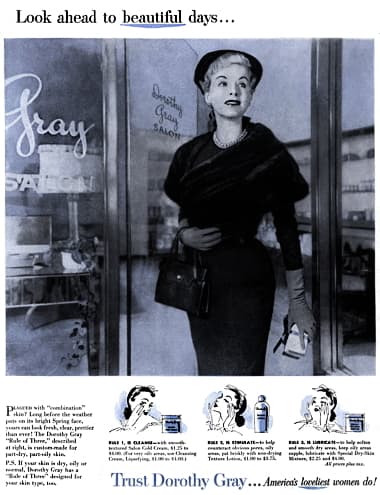
1952 Dorothy Gray.

1952 Dorothy Gray Fashion Sequence.
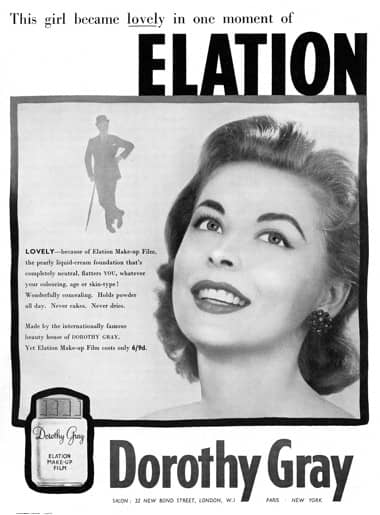
1955 Dorothy Gray Elation Make-up Film (Britain).
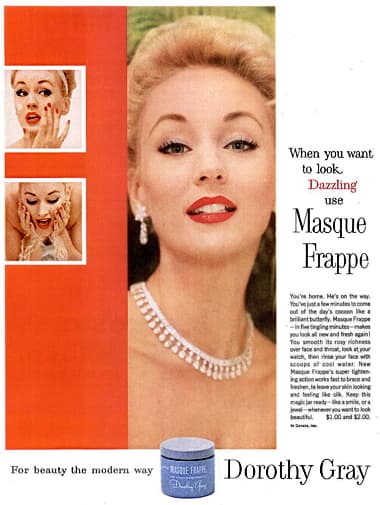
1956 Dorothy Gray Masque Frappe.

1956 Dorothy Gray Sheer Velvet Film.
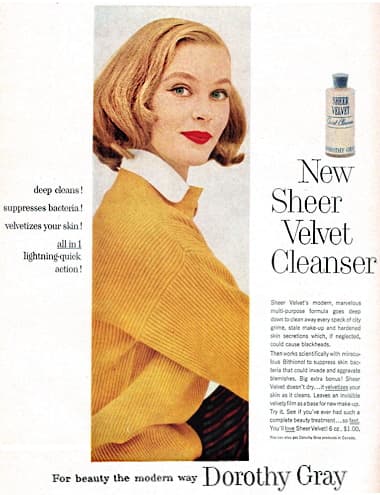
1956 Dorothy Gray Sheer Velvet Cleanser.
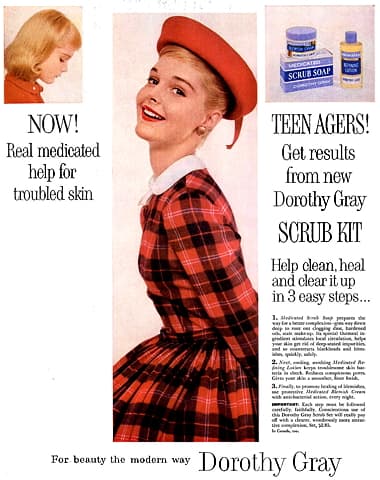
1956 Dorothy Gray Scrub Kit.
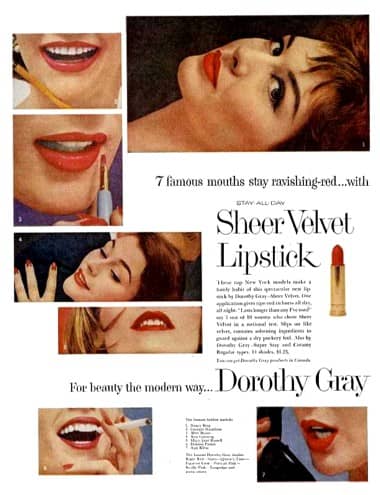
1956 Dorothy Gray Sheer Velvet Lipstick.
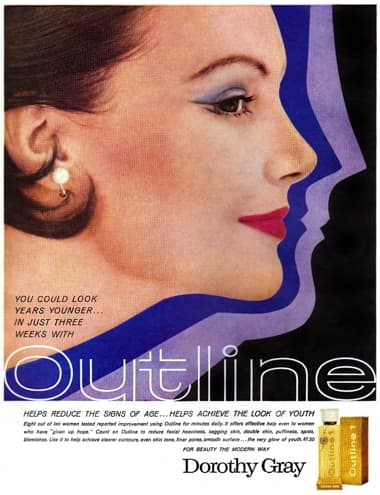
1957 Dorothy Gray Outline.
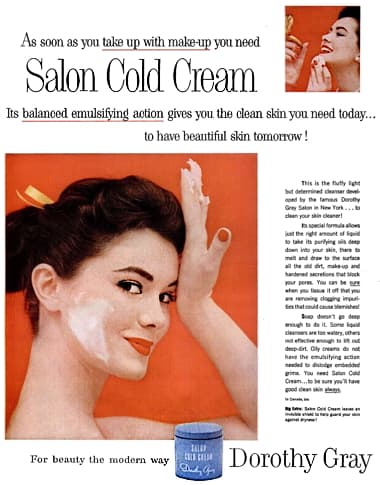
1957 Dorothy Gray Salon Cold Cream.
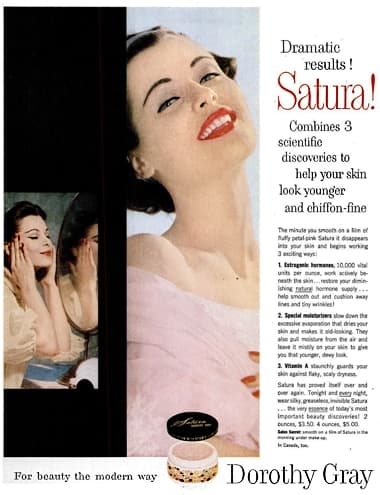
1957 Dorothy Gray Satura.
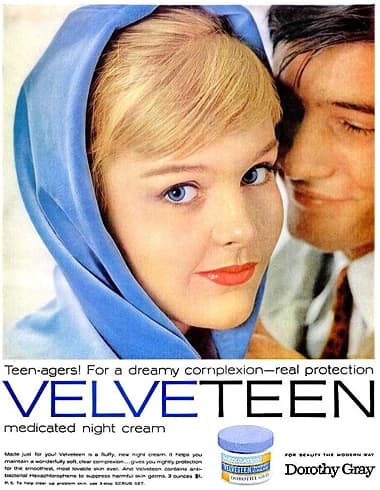
1958 Dorothy Gray Velveteen Night Cream.
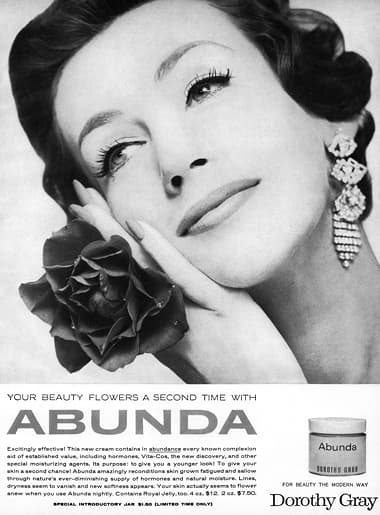
1958 Dorothy Gray Abunda.
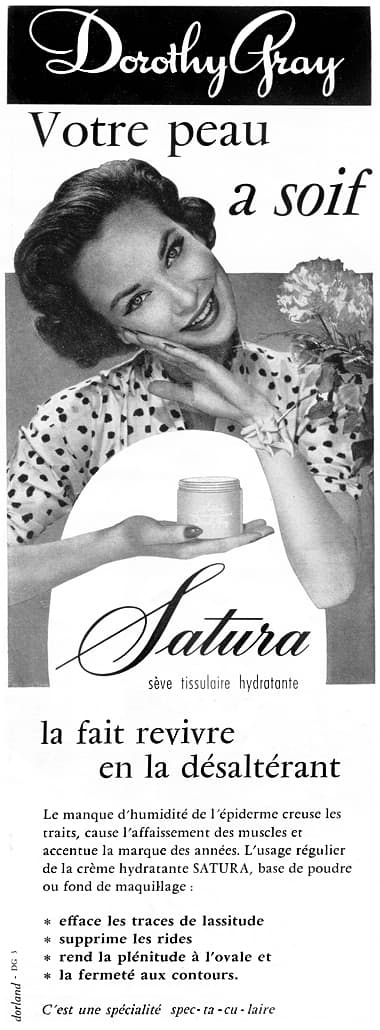
1958 Dorothy Gray Satura (France).
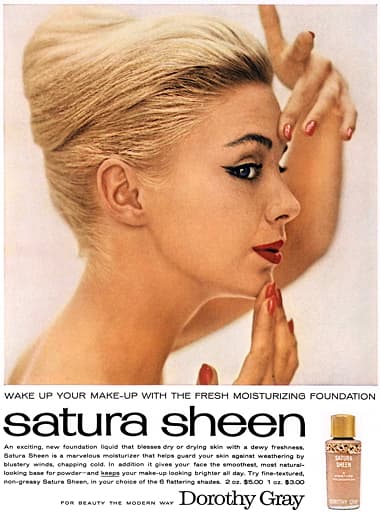
1958 Dorothy Gray Satura Sheen.
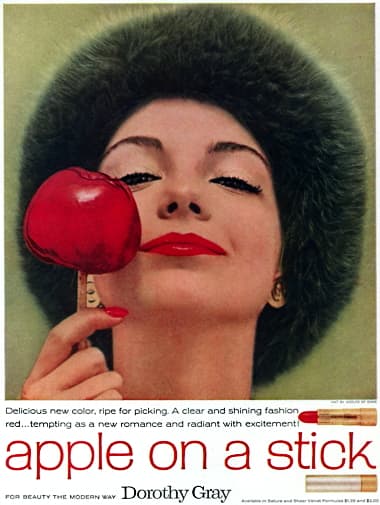
1958 Dorothy Gray Apple-on-a-Stick.

1959 Dorothy Gray Beauti-Lash.
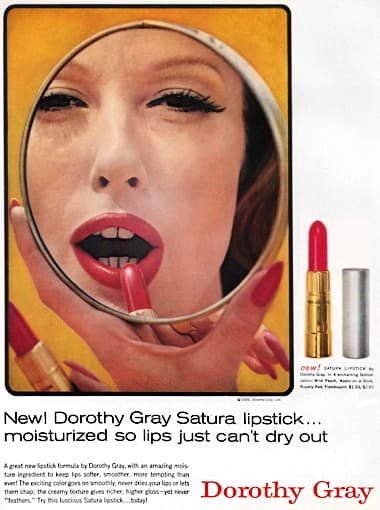
1959 Dorothy Gray Satura Lipstick.

1959 Dorothy Gray Eye Duo, Beauti-Lash, and Eyeshadow Stick.
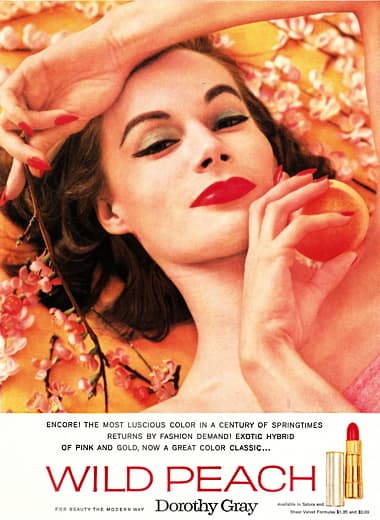
1959 Dorothy Gray Wild Peach.
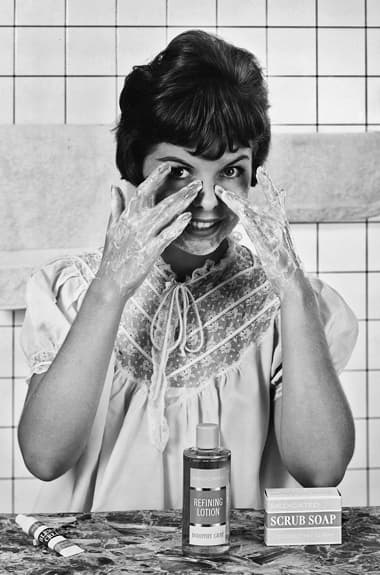
c.1961 Dorothy Gray Scrub Kit – Medicated Blemish Cream now in a tube, Medicated Refining Lotion, and Medicated Scrub Soap.
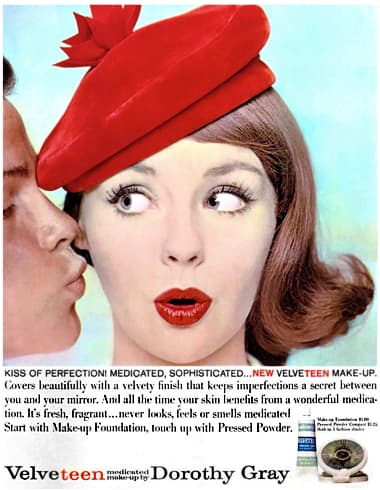
1961 Dorothy Gray Velveteen Medicated Make-up.
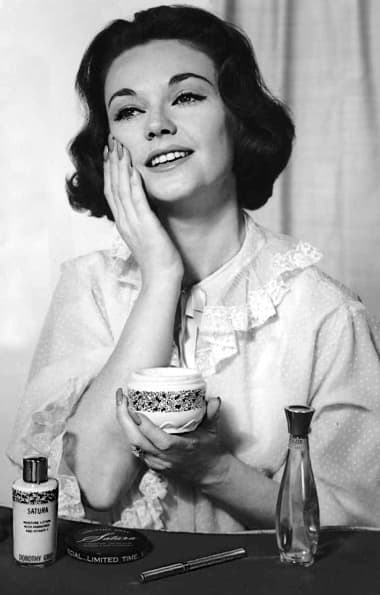
c.1961 Dorothy Gray Satura Moisture Lotion, Satura Moisture Cream, Fashion Slim Lipstick, and Tantalize After Bath Lotion.
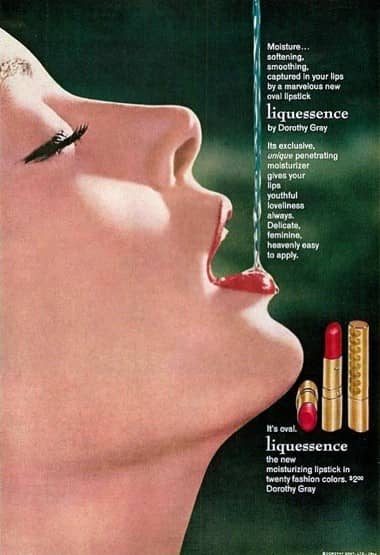
1965 Dorothy Gray Liquessence Lipsticks.
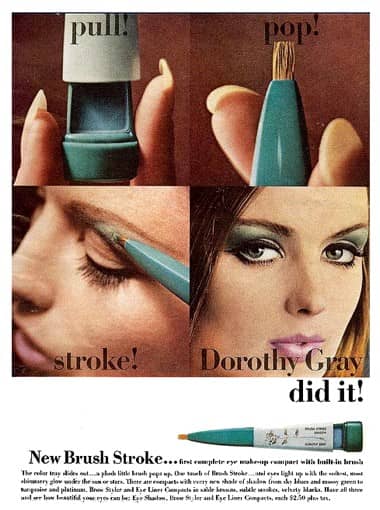
1965 Dorothy Gray Brushstroke.
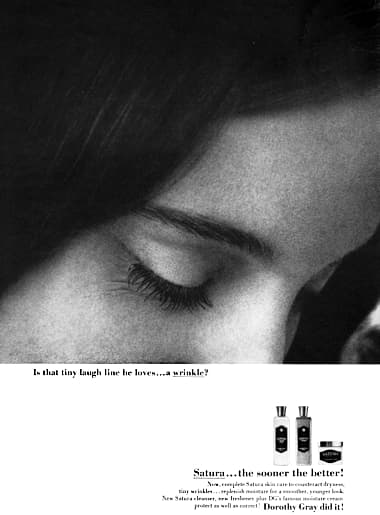
1965 Dorothy Gray Satura.
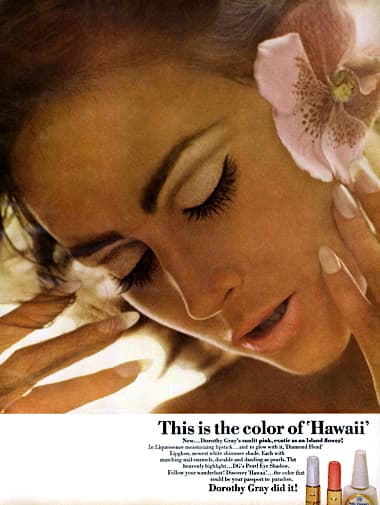
1966 Dorothy Gray Hawaii. The company had an Hawaii lipstick shade in 1938.
